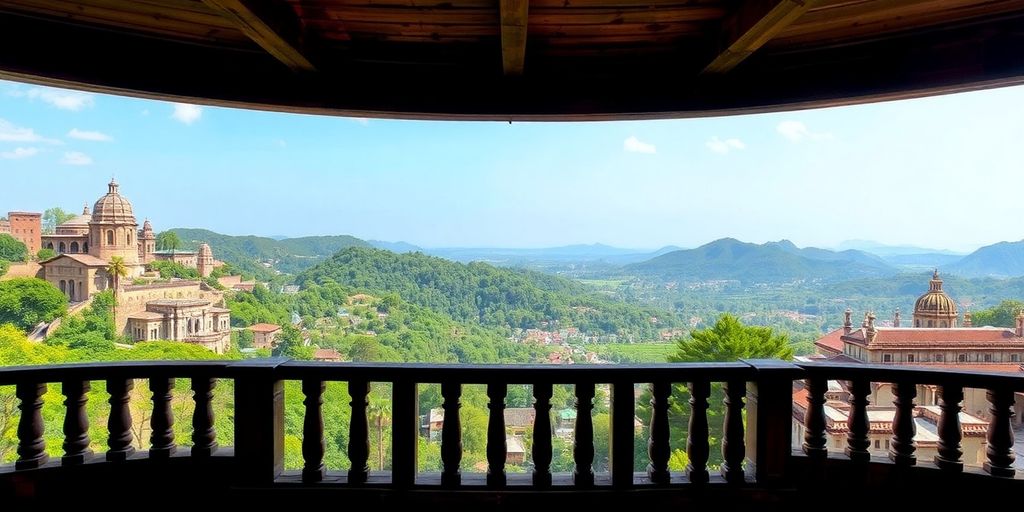Visiting UNESCO World Heritage Sites is a dream for many travelers. But for those looking for a more exclusive experience, securing private access can be a game changer. This guide will help you understand the ins and outs of gaining private access to these treasured locations, ensuring a unique and memorable visit while also respecting the heritage and local communities involved.
Key Takeaways
- Private access can enhance your experience at World Heritage Sites, allowing for less crowded visits.
- Understanding the legal framework is essential for securing permission to access these sites.
- Engaging with local communities can lead to richer experiences and support their economies.
- Sustainable tourism practices are crucial to protect these sites for future generations.
- Utilizing technology can simplify the process of planning and booking your private tour.
Understanding Private Access to World Heritage Sites
Defining Private Access
Okay, so what is private access when we’re talking about UNESCO World Heritage sites? It’s not as simple as just showing up whenever you want. Private access generally refers to opportunities to experience these sites in a more exclusive or personalized way than the typical tourist. This could mean anything from exclusive tours outside of normal hours to specially arranged visits that cater to specific interests. It’s about getting a deeper, more intimate connection with the site, often with fewer crowds and more tailored information. Think of it as upgrading from a standard visit to a VIP experience.
Benefits of Private Access
Why bother with private access? Well, the benefits can be pretty significant. For starters, you get to avoid the hordes of tourists that can sometimes detract from the experience. Imagine exploring the Great Wall of China without having to elbow your way through crowds! Beyond that, private access often comes with expert guides who can provide in-depth knowledge and answer all your questions. You might also get access to areas that are normally off-limits to the general public. Plus, it’s just a more comfortable and relaxed way to see these incredible places. Here’s a quick rundown:
- Fewer crowds, more space
- Personalized attention from expert guides
- Access to restricted areas
- A more relaxed and immersive experience
Challenges of Securing Access
Okay, so it all sounds amazing, right? But getting private access isn’t always a walk in the park. There can be a lot of hoops to jump through, and it often requires careful planning and a bit of luck. One of the biggest hurdles is navigating the local governance and regulations that govern these sites. Each site has its own rules and restrictions, and it can be tricky to figure out who to contact and what permissions you need. Funding and resources are also key to overcoming threats to these sites. Plus, it can be expensive, so you need to factor that into your budget. Here are some common challenges:
- Navigating complex regulations and permissions
- Dealing with high costs and limited availability
- Ensuring minimal impact on the site’s preservation
Securing private access to a World Heritage site requires a delicate balance. It’s about finding a way to enjoy these incredible places in a unique way while also respecting their cultural and historical significance and contributing to their long-term preservation. It’s not just about getting special treatment; it’s about experiencing these sites in a way that is both enriching and responsible. You might even find exquisite Michelin-star dining experiences on remote private islands.
Legal Framework for Access

International Treaties and Agreements
When we talk about accessing World Heritage Sites, it’s not just about buying a ticket. A whole bunch of international agreements are in play. The big one is the UNESCO World Heritage Convention of 1972. This agreement sets the stage for how countries should identify, protect, and preserve these sites. It’s like the constitution for heritage sites. Other conventions, like the Convention for the Safeguarding of the Intangible Cultural Heritage (2003), also play a role, especially when considering the cultural context of a site. These treaties create a framework for international cooperation, ensuring that everyone’s on the same page when it comes to protecting these irreplaceable places. The World Heritage Convention is a key document.
National Laws and Regulations
Each country that’s signed up for the World Heritage Convention then has to put its own laws and rules in place. These national laws are what actually make the international agreements work on the ground. They cover everything from how a site is managed to who gets access and under what conditions. For example, a country might have laws about building near a heritage site or about limiting the number of visitors. These laws also deal with things like preventing illegal digging or the sale of artifacts. It’s all about balancing tourism with preservation. These regulations are crucial for castle rentals.
Local Governance and Permissions
Okay, so you’ve got the international treaties and the national laws, but what about the people who actually live near the site? Local governments play a huge role in managing access. They often have their own rules and regulations that take into account the specific needs of the community and the environment. Getting permission to do something, like film a documentary or hold a special event, usually involves working with local authorities. This might mean dealing with permits, environmental impact assessments, and consultations with local communities. It’s all about making sure that access is sustainable and respectful.
It’s important to remember that accessing a World Heritage Site isn’t just a right; it’s a privilege. These sites are important to all of humanity, and we all have a responsibility to protect them. Understanding the legal framework is the first step in ensuring that our visits are both enjoyable and sustainable.
Planning Your Visit

Researching Heritage Sites
Okay, so you’re thinking about visiting a World Heritage Site? Awesome! First things first: do your homework. I mean, really do your homework. Don’t just skim a Wikipedia page the night before. Dig into the history, the cultural significance, and any specific rules or regulations for visitors. Understanding the site’s story makes the experience way more meaningful. Check out the World Heritage List for official info.
- Read books and articles about the site.
- Watch documentaries or videos.
- Explore virtual tours (if available).
Knowing the background will seriously enrich your visit. You’ll appreciate the site on a much deeper level, and you’ll be less likely to be that tourist who’s clueless about everything.
Contacting Site Management
Seriously, don’t skip this step. Before you book anything, reach out to the site management. Things change, you know? Opening hours, access restrictions, special events – all that stuff can impact your visit. Plus, they can often provide insider tips and advice that you won’t find anywhere else. It’s always better to be safe than sorry.
- Find contact information on the official website.
- Prepare a list of specific questions.
- Be patient – they might be busy.
Understanding Access Fees
Alright, let’s talk money. Most World Heritage Sites charge some kind of access fee, and it’s important to know what to expect. Fees can vary widely depending on the site, the time of year, and whether you’re booking a private art tour or just wandering around on your own. Some sites offer discounts for students, seniors, or families, so be sure to ask about those. Also, find out how to pay – cash, card, online booking? Knowing this ahead of time can save you a lot of hassle.
| Fee Type | Average Cost (USD) | Notes |
|---|---|---|
| General Admission | $10 – $30 | Varies by site and season. |
| Guided Tour | $20 – $50 | Often includes additional access. |
| Special Events | $50+ | Can include exclusive experiences. |
Engaging with Local Communities
It’s easy to forget that World Heritage sites aren’t just pretty pictures in a book. They’re living, breathing places often surrounded by communities with deep ties to the land. When planning private access, it’s super important to remember that you’re entering someone’s home, in a way. Ignoring the people who live there is a recipe for disaster. Instead, let’s look at how to make it a win-win for everyone.
Building Relationships
The first step is always to connect with the local community. Don’t just show up expecting to be catered to. Take the time to learn about their customs, traditions, and concerns. Attend local events, visit community centers, and most importantly, listen. Building trust takes time and effort, but it’s worth it. A good way to start is by finding a local guide who can act as a bridge between you and the community. They can provide valuable insights and help you navigate cultural nuances. Remember, you are a guest, and acting respectfully will go a long way. Consider participating in community meetings or workshops to show your interest and willingness to learn. This can also help you understand their perspectives on tourism and conservation efforts. For example, you might learn about traditional farming practices or local crafts that are essential to their way of life. By showing genuine interest, you can build a foundation of mutual respect and understanding.
Supporting Local Economies
Tourism can be a huge boost to local economies, but only if it’s done right. Make a conscious effort to spend your money at locally owned businesses. Eat at family-run restaurants, buy souvenirs from local artisans, and hire local guides and drivers. Avoid large, international chains that don’t contribute to the community. Supporting local economies ensures that the benefits of tourism are shared more equitably. This can involve purchasing locally sourced food for your meals, staying at locally owned guesthouses, or participating in community-based tourism initiatives. By doing so, you’re not only contributing to the economic well-being of the community but also helping to preserve their cultural heritage. For instance, you might visit a local weaving cooperative and purchase handmade textiles, or attend a traditional music performance organized by community members. These experiences not only enrich your visit but also provide valuable income for the local people. cultural festivals can be a great way to support the local economy.
Cultural Sensitivity and Respect
This should be a no-brainer, but it’s worth repeating: be respectful of local culture. Dress modestly, especially when visiting religious sites. Ask permission before taking photos of people. Learn a few basic phrases in the local language. And most importantly, be mindful of your behavior. What might be acceptable in your home country could be offensive in another culture. It’s always better to err on the side of caution.
Remember that you are a visitor in their home. Treat their customs, traditions, and beliefs with the utmost respect. This includes being mindful of your language, gestures, and interactions with local people. By demonstrating cultural sensitivity, you can create positive experiences for both yourself and the community.
Here’s a quick guide to help you be more culturally sensitive:
- Learn about local customs and traditions before you go.
- Dress modestly and respectfully.
- Ask permission before taking photos of people.
- Be mindful of your body language and gestures.
- Learn a few basic phrases in the local language.
By following these simple guidelines, you can ensure that your visit is both enjoyable and respectful. local festivals are a great way to experience the local culture. Remember, your actions can have a big impact on the community, so always strive to be a responsible and respectful traveler. Consider the impact of your visit on the environment and the local way of life. Choose eco-friendly accommodations and activities, and avoid contributing to pollution or resource depletion. By making sustainable choices, you can help preserve the heritage site for future generations. private events can offer a more intimate cultural experience.
Sustainable Tourism Practices
Eco-Friendly Travel Options
Okay, so you want to see some amazing places, right? But getting there can be a real drag on the environment. Think about it: planes, trains, and automobiles – they all leave a footprint. But there are ways to lessen the impact. Consider taking public transportation once you arrive at your destination. It’s often cheaper and gives you a better feel for the local culture. Carbon offsetting is another option; some airlines and travel companies let you pay a little extra to support projects that reduce carbon emissions. Walking or biking, when feasible, is always a great choice, too!
- Use public transport.
- Rent a bike.
- Walk whenever possible.
Minimizing Environmental Impact
Once you’re at a World Heritage site, it’s super important to tread lightly. These places are often fragile ecosystems, and even small actions can have big consequences. Stick to marked trails to avoid trampling vegetation or disturbing wildlife. Dispose of your trash properly – and even better, pack out everything you pack in. Avoid using single-use plastics; bring a reusable water bottle and shopping bag. And definitely don’t take any souvenirs from the site itself – leave everything as you found it for others to enjoy. You can also look into sustainable tourism options.
Promoting Responsible Behavior
Being a responsible tourist is about more than just minimizing your environmental impact; it’s also about respecting the local culture and communities. Learn a few basic phrases in the local language. Dress modestly when visiting religious sites. Be mindful of noise levels, especially in residential areas. Support local businesses by buying souvenirs and eating at local restaurants. And most importantly, be open to learning about different cultures and perspectives. It’s all about being a respectful guest and leaving a positive impression. Consider space tourism as a way to promote responsible behavior.
Remember, these sites are important to the people who live there, and they’re important to the world. By traveling responsibly, you can help ensure that they’re preserved for future generations.
Private Tours and Exclusive Experiences

So, you’re thinking about ditching the crowds and seeing a World Heritage site in style? Private tours and exclusive experiences are the way to go. It’s not just about bragging rights; it’s about getting a deeper, more personal connection with these incredible places. Let’s break down how to make it happen.
Finding Reputable Tour Operators
Okay, first things first: you need a tour operator who knows their stuff. Don’t just go with the first one you see online. Do some digging. Look for operators who:
- Have solid reviews and testimonials. Real people sharing real experiences are gold.
- Are specialized in heritage sites. You want someone who understands the history and significance.
- Are transparent about their practices. No hidden fees or shady dealings.
It’s worth spending a little extra time here. A good tour operator can make or break your experience. They’re your key to unlocking the secrets of the site and ensuring everything runs smoothly.
Customizing Your Itinerary
This is where the fun begins! A private tour means you get to call the shots. Want to spend extra time in a particular area? No problem. Interested in a specific aspect of the site’s history? Let them know. The best tour operators will work with you to create an itinerary that matches your interests and pace. Consider these options:
- Themed tours: Focus on art, architecture, or a specific historical period.
- Behind-the-scenes access: Get into areas not open to the general public.
- Meet-and-greets: Arrange meetings with local experts or artisans.
For example, Paltino specializes in creating bespoke travel experiences for the ultra-wealthy, focusing on luxurious island-hopping adventures.
Safety and Security Considerations
Okay, let’s talk safety. When you’re dealing with exclusive access, you need to be extra careful. Make sure your tour operator has a solid safety plan in place. This includes:
- Emergency protocols: What happens if something goes wrong?
- First aid and medical support: Are they equipped to handle injuries?
- Security measures: How do they protect you from potential threats?
Also, trust your gut. If something feels off, don’t be afraid to speak up or even cancel the tour. It’s better to be safe than sorry. For example, explore private art tours tailored for collectors and enthusiasts in major cities.
| Consideration | Details
Conservation Efforts and Their Importance
Role of UNESCO
UNESCO plays a vital role in safeguarding World Heritage sites. It brings nations together to protect exceptional natural and cultural sites. The organization monitors the state of conservation, offers technical help, and strengthens the skills of those involved in heritage work. UNESCO also backs projects that aim to protect and manage World Heritage sites effectively for current and future generations. The World Heritage Convention unites almost all countries with the common goal of conserving exceptional sites.
Community Involvement in Conservation
Getting local communities involved is super important for keeping these sites safe. It’s not just about protecting the sites themselves; it’s also about helping the people who live nearby. World Heritage sites can create jobs and bring in money through tourism, which helps improve the well-being of local communities. For example, the iSimangaliso Wetland Park in South Africa generated over 12,000 jobs after its World Heritage listing. It’s a win-win when conservation efforts also support the people who call these places home.
Funding and Support Mechanisms
Protecting these sites costs money, and a lack of long-term funding is a big worry for many natural World Heritage sites. We need to find ways to support the work being done to protect these precious places. This can involve donations, corporate commitments, and other financial mechanisms. The Central Africa World Heritage Forest Initiative is one example of how funding can be directed to specific regions to strengthen site management and integration within ecological landscapes.
If natural World Heritage sites aren’t adequately protected, their unique values could be irreversibly damaged or lost. Effective management and sufficient resources are key to overcoming threats to these sites.
Here are some ways to support conservation efforts:
- Donate to organizations working to protect World Heritage sites.
- Support businesses that have policies to safeguard these sites.
- Raise awareness about the importance of conservation.
Technology and Access Innovations
Virtual Tours and Augmented Reality
Okay, so picture this: You’re dying to see Machu Picchu, but plane tickets are crazy expensive, and you can’t get time off work. What if you could virtually walk through the site? That’s where virtual tours come in. They’re getting seriously good, with 360-degree views and even interactive elements. Augmented reality travel itineraries takes it a step further. Imagine holding up your phone and seeing a long-gone civilization come to life right before your eyes. It’s like stepping back in time, without the time machine.
Mobile Apps for Site Information
Forget lugging around heavy guidebooks. Now, everything you need is on your phone. Mobile apps are a game-changer. They offer:
- Detailed site histories
- Interactive maps
- Real-time updates on closures or special events
- Offline access (because let’s face it, Wi-Fi isn’t always reliable)
Some apps even have audio guides and translation features. It’s like having a personal tour guide in your pocket. Plus, you can often find innovative itineraries that are tech-focused.
Online Booking Systems
Remember the days of waiting on hold for hours to book a tour? Yeah, those are (thankfully) fading. Online booking systems make planning your visit so much easier. You can:
- Check availability in real-time
- Compare prices from different tour operators
- Securely pay online
- Receive instant confirmation
It’s all about convenience. These systems not only streamline the booking process but also help site managers control visitor flow and manage capacity, which is super important for conservation efforts.
And for those looking for something truly unique, keep an eye out for companies offering private spaceflights bookable online – talk about a once-in-a-lifetime experience!
Case Studies of Successful Access Initiatives
Notable Examples of Private Access
It’s interesting to look at how some places have made private access work. One example is the Community Management of Protected Areas Conservation (COMPACT) initiative. This program focuses on getting local communities involved in taking care of World Heritage sites. The idea is that if the people who live near these sites benefit from them, they’ll be more likely to help protect them. COMPACT provides small grants and support to community-based projects. For example, in Belize, they helped fishing communities become advocates for marine protected areas. They’ve also worked in places like Sian Ka’an in Mexico, where they’ve supported sustainable management of community lands. The COMPACT initiative is an innovative model for engaging communities in conservation and shared governance of World Heritage sites.
Here’s a quick look at some other successful initiatives:
- Belize Barrier Reef (Belize): Fishing communities now advocate for marine protected areas.
- Sian Ka’an (Mexico): 60,000 hectares of community lands are under sustainable management.
- Morne Trois Pitons (Dominica): Indigenous youth document traditional herbs for biodiversity enterprises.
- Mt. Kenya (Kenya): The Mt. Kenya Donor Forum has helped to secure some US$35 million from donors to complement COMPACT projects in the World Heritage site.
- Mt. Kilimanjaro (Tanzania): The creation of the Kilimanjaro network of grantees (COMPAKIN) is helping to sustain community-based efforts once the donor support comes to an end by providing a forum for information exchange and joint resource mobilization.
- Simien National Park (Ethiopia): The COMPACT project has supported projects concerned with land degradation.
- Rainforests of the Atsinanana (Madagascar): The COMPACT model has been introduced the model in two national parks within this World Heritage site.
- W-Arly-Pendjari Complex (Benin, Burkina Faso and Niger): Activities have focused on supporting local communities’ development and resilience to climate change through agricultural techniques that are compatible with biodiversity conservation.
- Maloti-Drakensberg (Lesotho/South Africa): COMPACT is contributing to undertake activities on the ground such as training the broader community on livestock and rangeland management.
- Okavango Delta (Botswana): COMPACT is supporting the establishment of a conservation programme constituting a permanent structure to support the involvement of local communities.
Lessons Learned from Successful Programs
So, what makes these programs work? A big part of it is getting everyone involved. COMPACT uses a method that’s based on science but also makes sure to include local people and other stakeholders. They believe that communities will only get involved in conservation if they see clear benefits for themselves. It’s also important to have transparent processes and good governance. This means being open about how decisions are made and making sure everyone has a chance to participate. The off-grid luxury retreats are gaining popularity as travelers seek privacy and adventure away from crowded tourist spots.
COMPACT takes a landscape approach, finding constructive ways to work with a diverse range of communities and stakeholders living in and caring for protected areas and the broader landscape.
Impact on Local Communities
These initiatives can have a big impact on local communities. They can help improve livelihoods, preserve cultural heritage, and empower people to take control of their own resources. For example, in Dominica, indigenous youth are using their knowledge of traditional herbs to create small businesses. In Tanzania, a network of grantees is helping communities continue their conservation efforts even after donor funding ends. By supporting these kinds of projects, we can help ensure that World Heritage sites benefit both visitors and the people who call them home.
Future Trends in Heritage Site Access
Emerging Technologies
Technology is changing how we experience heritage sites. Think about it: virtual reality tours are becoming more common, letting people explore places from home. Augmented reality apps can overlay information onto real-world views, giving visitors a richer experience. These technologies can make sites more accessible and engaging, but it’s important to balance innovation with preserving the authenticity of the site.
Changing Visitor Demographics
The people who visit heritage sites are changing. There are more older travelers, more families, and more people from different cultural backgrounds. This means sites need to adapt to meet different needs. For example:
- Offering tours in multiple languages.
- Making sites more accessible for people with disabilities.
- Creating activities that appeal to children.
It’s also important to consider the impact of social media. People share their experiences online, which can influence where others choose to visit. Sites need to manage their online presence and engage with visitors in a meaningful way.
Policy Changes and Their Implications
Policies around heritage site access are always evolving. Governments and organizations like UNESCO are constantly working to balance preservation with tourism. This can lead to new regulations about things like:
- Visitor numbers.
- Access fees.
- Permitted activities.
These changes can affect how people experience sites, so it’s important to stay informed. For example, new policies might limit private art tours to protect fragile ecosystems. Also, the rise of luxury space travel could influence how we perceive and access remote or previously inaccessible heritage locations.
Advocacy for Heritage Site Protection

Role of NGOs and Activists
Non-governmental organizations (NGOs) and activists play a huge role in protecting World Heritage sites. They act as watchdogs, monitoring the condition of sites and advocating for their preservation. These groups often bring attention to issues that governments and international bodies might overlook. They also work to educate the public about the importance of these sites and the threats they face. For example, some NGOs focus on environmental DNA research to monitor biodiversity.
Public Awareness Campaigns
Public awareness is key to heritage site protection. If people don’t know about these places, or don’t understand why they’re important, they won’t care if they’re damaged or destroyed. Public awareness campaigns can take many forms, from social media posts and documentaries to educational programs in schools. Effective campaigns highlight the cultural, historical, and environmental significance of these sites, and they inspire people to take action to protect them. These campaigns can also promote luxury off-grid retreats that support conservation efforts.
Collaborative Efforts for Preservation
Protecting World Heritage sites requires collaboration between many different groups. This includes governments, NGOs, local communities, and international organizations like UNESCO. When everyone works together, it’s possible to achieve much more than any one group could on its own. Collaborative efforts can involve:
- Sharing resources and expertise
- Developing joint management plans
- Coordinating conservation efforts
It’s important to remember that heritage sites are not just relics of the past; they are living parts of our world that need our care and attention. By working together, we can ensure that these sites are protected for future generations to enjoy. We need to support sustainable development to ensure the long-term health of these sites.
Protecting our heritage sites is crucial for preserving our history and culture. These places tell the stories of our past and connect us to our roots. We need your help to advocate for their protection. Join us in this important mission! Visit our website to learn how you can make a difference today!
Final Thoughts on Protecting Our Heritage
Securing private access to UNESCO World Heritage Sites is no small task. It takes a mix of careful planning, community involvement, and a commitment to sustainability. By working together—governments, local communities, and private sectors—we can create a balance that allows people to enjoy these incredible places while also protecting them for future generations. Remember, every little bit helps. Whether it’s supporting local initiatives or simply spreading the word about the importance of these sites, we all have a role to play. Let’s keep these treasures safe and sound.
Frequently Asked Questions
What does private access to World Heritage Sites mean?
Private access means having special permission to visit a World Heritage Site that is not available to the general public. This can include private tours or exclusive events.
Why should I consider private access?
Private access can provide a more personal experience, allowing you to explore the site without large crowds. It often includes expert guides who can share deeper insights about the site.
What are some challenges in getting private access?
Securing private access can be difficult due to strict regulations, high costs, and the need to coordinate with local authorities or site managers.
What legal rules should I know about?
There are international agreements, national laws, and local regulations that govern access to World Heritage Sites. It’s important to research these before planning your visit.
How can I plan my visit to a World Heritage Site?
Start by researching the site, then contact the management team to ask about private access options and any fees that may apply.
How can I connect with local communities while visiting?
Building relationships with local people can enhance your experience. Consider supporting local businesses and being respectful of their culture.
What are sustainable tourism practices I should follow?
Choose eco-friendly travel options, reduce waste, and behave responsibly to minimize your impact on the environment and the local community.
What are some examples of successful private access initiatives?
Some notable examples include private tours that support conservation efforts and partnerships with local communities to enhance visitor experiences.












